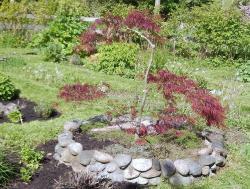For the past few years, it looks fine until about mid-August or so. Then the outer leaves begin to discolor and wilt. It appears from my reading that the wilt can stay in the soil for 10+ years, so looks like I'll need to figure out something else for that spot. On the plus side, perhaps it is contained within the rock circle and has not spread into the adjacent beds. I have a dahlia close by which is also susceptible to this fungus, and will keep a close eye on it this season.
Yes, it's disappointing, but on the other hand, after three maple failures at least I can pin down the underlying issue.
Any suggestions on a smallish focal point tree/shrub for this spot?
